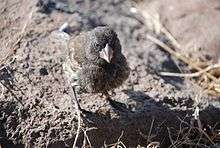Large cactus finch
| Large cactus finch | |
|---|---|
 | |
| On Española Island, the Galápagos Islands, Ecuador | |
| Scientific classification | |
| Kingdom: | Animalia |
| Phylum: | Chordata |
| Class: | Aves |
| Order: | Passeriformes |
| Family: | Thraupidae |
| Genus: | Geospiza |
| Species: | G. conirostris |
| Binomial name | |
| Geospiza conirostris Ridgway, 1890 | |
The large cactus finch (Geospiza conirostris) is a species of bird in the tanager family Thraupidae. It is one of Darwin's finches, and is endemic to the Galápagos islands, Ecuador, where it is restricted to Española, Genovesa, Darwin, and Wolf Islands. This rather dark bird resembles the smaller and finer-beaked common cactus finch, but the two species do not co-inhabit any island. There are significant differences between the subspecies of the large cactus finch; G. c. conirostris of Española has a far larger beak than G. c. darwinii and G. c. propinqua of the remaining three islands.
Its natural habitat is dry shrubland and it is commonly seen on the ground. Its main food source is the cactus Opuntia.
Taxonomy
The large cactus finch is one of Darwin's finches, a group of closely related birds which evolved on the Galápagos Islands. The group is related to the Tiaris grassquits, which are found in South America and the Caribbean.[2] An ancestral relative of those grassquits arrived on the Galápagos Islands some 2–3 million years ago, and the large cactus finch is one of the species which evolved from that ancestor.[3] There are three subspecies:
- G. c. conirostris is found on the island of Española.
- G. c. darwinii is found on the islands of Darwin and Wolf.
- G. c. propinqua is found on the island of Genovesa.[4]
First described by Robert Ridgway in 1890, the large cactus finch is one of six species the genus Geospiza.[5] The name Geospiza is a combination of the Greek words geo-, meaning "ground-" and spiza, meaning finch.[6] The specific name conirostris comes from the Latin conus, meaning "cone" and rostris, meaning "-billed" (rostrum = bill).[7] Although this species was originally described as a finch, DNA research has now shown that all of Darwin's "finches" are actually tanagers.[8]
Description
The large cactus finch is among the largest of the Darwin's finches, measuring 15 cm (5.9 in) in length. The male is black, with white-tipped undertail coverts. Female and immature birds range in color from dull gray to matte black, and frequently show white edges to the feathers of their underparts.[4]
Range and habitat
Endemic to the Galápagos, the large cactus finch is found only on the islands of Española, Darwin, Wolf and Genovesa. It is not found on any island where the common cactus finch occurs.[4]
 Female on Española
Female on Española Male on Española
Male on Española
References
- ↑ BirdLife International (2012). "Geospiza conirostris". IUCN Red List of Threatened Species. Version 2013.2. International Union for Conservation of Nature. Retrieved 26 November 2013.
- ↑ Newton, Ian (2003). Speciation and Biogeography of Birds. San Diego, CA, USA: Academic Press. p. 78. ISBN 978-0-12-517375-9.
- ↑ Grant & Grant (2008), p. 25.
- 1 2 3 Swash, Andy; Still, Rob. Birds, Mammals, and Reptiles of the Galápagos Islands: An Identification Guide (2nd ed.). London, UK: Christopher Helm. p. 104. ISBN 978-0-300-11532-1.
- ↑ Donahue, Kathleen (2011). Darwin's Finches: Readings in the Evolution of a Scientific Paradigm. Chicago, IL, USA: University of Chicago Press. p. 154. ISBN 978-0-226-15771-9.
- ↑ Jobling (2010), p. 172.
- ↑ Jobling (2010), p. 116.
- ↑ Tudge, Colin (2008). The Bird: A Natural History of Who Birds Are, Where They Came From, and How They Live. New York, NY, USA: Random House. p. 183. ISBN 978-0-307-34205-8.
Cited works
- Grant, Peter R.; Grant, B. Rosemary (2008). How and Why Species Multiply: The Radiation of Darwin's Finches. Princeton, NJ, USA: Princeton University Press. ISBN 978-0-691-13360-7.
- Jobling, James A. (2010). Helm Dictionary of Scientific Bird Names. London, UK: Christopher Helm. ISBN 978-1-4081-2501-4.
External links
| Wikimedia Commons has media related to Geospiza conirostris. |
